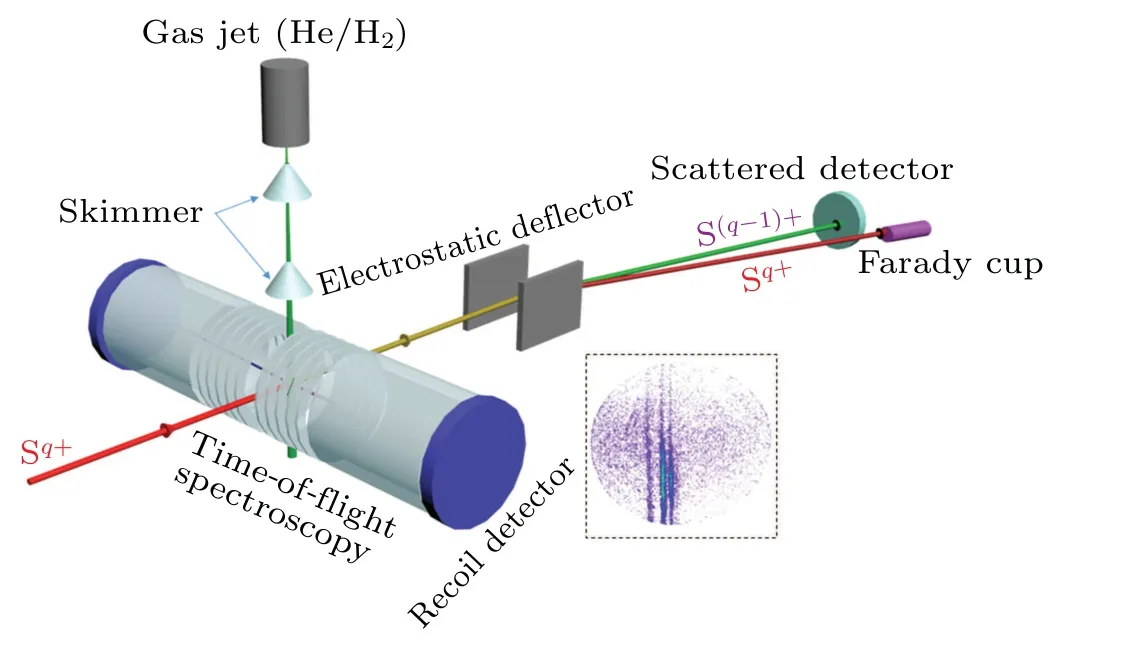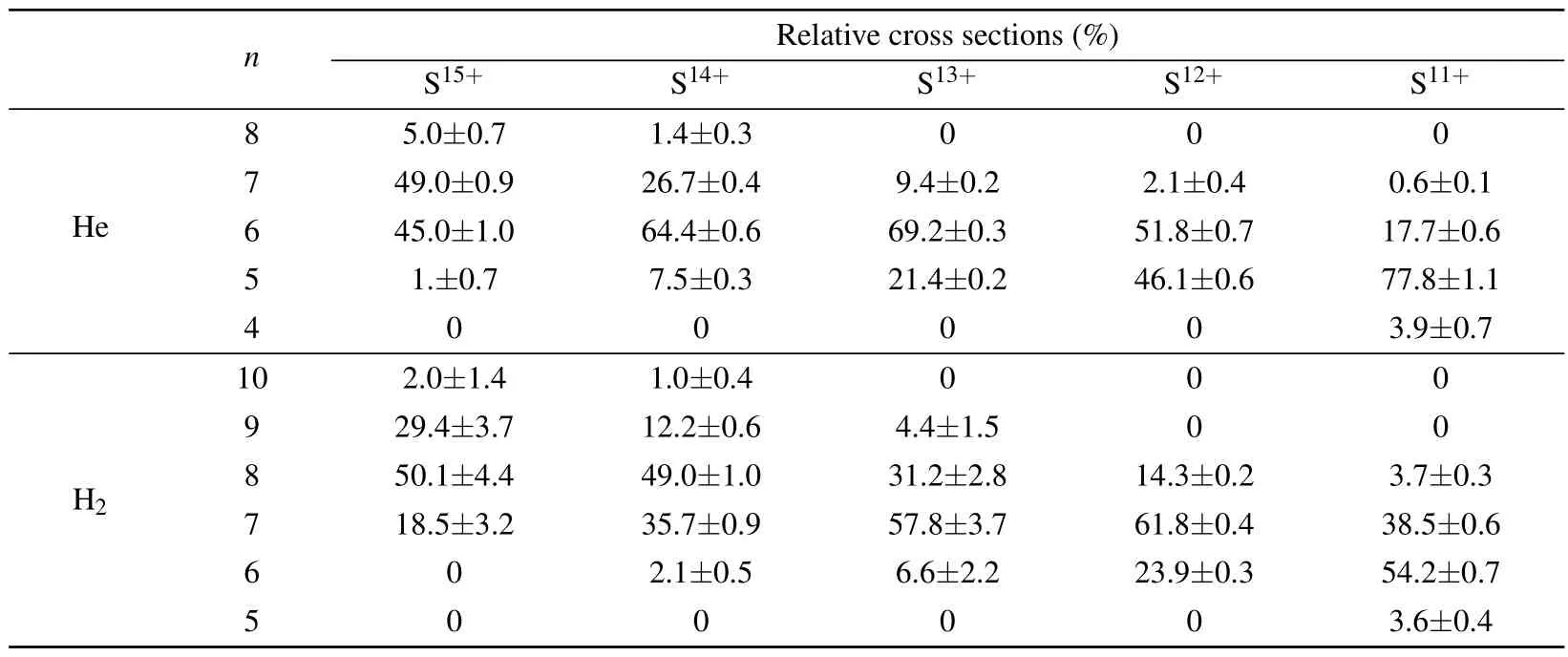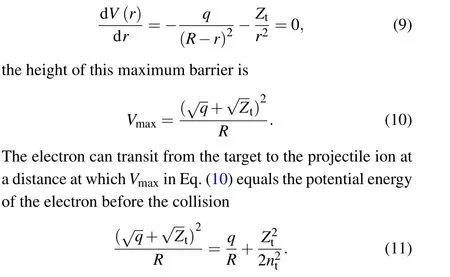State-selective charge exchange cross sections in collisions of highly-charged sulfur ions with helium and molecular hydrogen
Xiaolong Zhu(朱小龙), Shucheng Cui(崔述成), Dadi Xing(邢大地), Jiawei Xu(徐佳伟),B.Najjari, Dongmei Zhao(赵冬梅), Dalong Guo(郭大龙),2, Yong Gao(高永),2,Ruitian Zhang(张瑞田),2, Maogen Su(苏茂根), Shaofeng Zhang(张少锋),2, and Xinwen Ma(马新文),2,‡
1Institute of Modern Physics,Chinese Academy of Sciences,Lanzhou 730000,China
2School of Nuclear Science and Technology,University of Chinese Academy of Sciences,Beijing 100049,China
3Key Laboratory of Atomic and Molecular Physics and Functional Materials of Gansu Province,College of Physics and Electronic Engineering,Northwest Normal University,Lanzhou 730070,China
4Joint Laboratory of Atomic and Molecular Physics,Northwest Normal University and Institute of Modern Physics,Chinese Academy of Sciences,Lanzhou 730070,China
5Advanced Energy Science and Technology,Guangdong Laboratory,Huizhou 516000,China
Keywords: highly charged sulfur ion,charge exchange,state-selective cross sections,COLTRIMS
1.Introduction
Since the first x-ray image of Comet C/Hyakutake 1996 B2 with the ROSAT telescope was reported,[1]the charge exchange investigation has become a hot topic.Solar wind ions contain a large proportion of protons and alpha particles(more than 99%), and a smaller proportion of highly charged heavy ions,such as C,N,O,Si,S,Fe and so on.[2–4]Although,heavy ions represent a small fraction in the solar wind, they are the major contribution to the x-ray source from astrophysical objects and environments.Charge-exchange collisions between these ions and neutral atoms/molecules can leave the ions in highly excited states.These highly excited ions then decay to lower energy states by spontaneous emission of photons in the x-ray range.The interplay or understanding of the observed xray spectra requires more atomic data for the charge exchange.Most of the existing data on charge exchange reaction rates were mainly obtained by theoretical calculations, and only a few measurements were performed using various experimental methods.[5]With the development of the cold target recoil ion momentum spectrometer (COLTRIMS) or reaction microscopy technique,[6,7]the state-selective capture cross sections in collisions between highly charged ions and atoms can be easily obtained at solar wind velocities.However,theoretical calculations face a large challenge.For collisions between highly charged ions and atoms, the captured electron always prefers to populate into the higher states of the projectile ion,the theoretical calculation needs to include the ground state to higher states, and the time cost of calculation is very high even over the ability of the computer.The review paper shows the progress and challenges of atomic structure and collision dynamics with highly charged ions.[8]
Sulfur ions as an important species of the solar wind were also observed in astrophysical objects and environments.[9–12]The mysterious 3.5 keV line observed in XMM-Newton observations of the galaxy clusters in 2014[13,14]was attributed to the emission from the charge exchange of bare sulfur ion with neutral component interactions by Guet al.[15]and has been confirmed by Shahet al.experimentally.[16]
Studies of charge exchange involving sulfur ions remain relatively rare.Wilsonet al.measured the state-selective electron capture by S3+ions from H, H2and He at impact energies in the range of 2.4–9.0 keV using the translational energy spectroscopy technique.[17]Labudaet al.reported a theoretical investigation of the state selective electron capture in the collision of S3+ions with atomic hydrogen and helium at low impact energy.[18]The theoretical description presented in Ref.[18]is based on anab-initiomolecular calculation of the potential energy curves and couplings combined with semiclassical description of the collision dynamics.Wanget al.[19]investigated theoretically the charge transfer in collisions of ground-state S4+(3s21S)ions with the helium atom at energies between 0.1 meV/u and 10 MeV/u utilizing the quantum mechanical molecular-orbital close-coupling(QMOCC),atomicorbital close-coupling (AOCC), classical trajectory Monte Carlo(CTMC)and continuum distorted wave methods.Zhaoet al.[20]reported a comparative study of charge transfer in collisions of ground-state S2+ions with the He by fully quantum and semiclassical molecular-orbit close-coupling approaches at collision energies between 10 eV/u and 10 keV/u.However,for highly charged sulfur ions at solar wind velocities,no theoretical investigation of highly charged sulfur ions with helium and molecular hydrogen collisions is available,which is due to strong Coulomb interactions,electrons are more likely captured into highly excited states of the projectile, and the method based on quantum mechanics is time consuming.For example, the QMOCC calculations have difficulty to include these important high excitation channels.So the classical model is usually used to calculate the total cross-sections and quantum state population of charge transfer between highly charged ions and atoms or molecules at solar wind velocities,such as multi-channel Landau–Zener method,[21]over-barrier models[22]and also some scaling laws.[23,24]
Yet, the study of charge exchange of sulfur ions, which represent important species of the solar wind,remains rare,in particular, the state-selective electron capture process.In the present work,we study the state-selective single electron capture (SEC) of highly charged Sq+ions (q=11–15) colliding with the helium and molecular hydrogen neutral targets at an impact energy ofq×20 keV.
2.Experimental setup
The experiment is performed at the IMP EBIS-A facility combined with cold target recoil ion momentum spectroscopy(COLTRIMS).[6,7,25,26]The experimental details can be found in Refs.[25,26].Here is only a brief description.The sulfur ions are produced in the electron beam ion source(EBIS)with the injection gas H2S.The ion beam is extracted from EBIS with electric fields and passes through the Wien filter.The expected charge state of sulfur ions is selected,and then accelerated into a desired energy by a high-voltage platform.The selected ion beam is collimated before the collision chamber with four-jaw slits and then crosses the super-sonic gas jet at the center of the collision chamber.The produced target ions are extracted by uniform electric fields perpendicular to the beam and gas jet direction and guided into a position-sensitive detector with a delay line anode.The scattered projectile ions are analyzed by a parallel plate deflector and then detected by the position sensitive 2D detector similar to the recoil detector as shown in Fig.1.The inset of Fig.1 depicts a typical result of the recoil ion detector for a single electron capture (SEC)in S14+–He collisions at the collision energy of 280 keV.The separated vertical structures correspond to the electron capture into different states of the projectile ion.
For the single electron capture in collision of Sq+with atoms or molecules,the reaction process is expressed as
whereqis the charge state of the projectile,Bis the atomic or molecular target,andnrepresents the principal quantum number of the projectile populated by the captured electron.
For the pure electron capture process in the collision,according to the energy and momentum conservation, the reaction energyQ(the energy change of the active electrons before and after the reaction) can be obtained from the longitudinal momentum transfer to the recoil ion (Plong) according to the following equation:
wherevpis the velocity of the projectile,andncis the numbers of captured electrons from the target.Note that all quantities are given in atomic units and in laboratory frame.

Fig.1.The experimental scheme of COLTRIMS.
3.Results and discussion
We present the results concerning the relativen-stateselective cross sections for single electron capture in collisions between Sq+and helium and molecular hydrogen.We have converted the recoil longitudinal momentum distributions intoQ-value distributions using Eq.(2).Figure 2 shows the measuredQspectra of SEC in Sq+–He and Sq+–H2collisions at impact energies ofq×20 keV.Also the relevant capture channels are indicated in the graphs.The left panels show the helium target, and the right panels correspond to the molecular hydrogen targets.The experimental resolution is enough to separate the capture channels with different principal quantum numbers of the projectile.Indeed, theQ-value spectra show that only one or twon-shells are significantly populated.The increase in the projectile chargeqwill lead to the shift to higher values of populated principal quantum numbersn.Relative partial cross sections for capture into differentn-shells are obtained by Gaussian fits of the peaks in theQ-value spectra and listed in Table 1.Here,the relative cross sections were determined from the ratio of the area under each reaction channel to the total signal,σn/σtot.The errors only consider the statistical error.

Table 1.Measured relative state-selective cross sections for SEC in Sq+–He and H2 collisions at impact energies of q×20 keV.q is the charge state of the projectile.
For then-shell population of the electron capture in slow collisions,the simple scaling laws on then-state population of SEC were proposed by Otrantoet al.,[23]Janev&Winter,[24]Tawaraet al.[27]and Iwaiet al.[28]based on the over-barrier model.[22]According to these models,the most probable principal quantum number populated by the captured electron is given by
whereIHandItare the first ionization energies of the atomic hydrogen and the neutral target, respectively,qis the charge state of the projectile ion,andZtis the effective charge of the atomic or molecular target.
Here, a brief description of the classical over-barrier model (OBM) is provided.For the single electron capture of highly charged ions with the helium target,the projectile ions are approximated by bare nuclei with an effective chargeqand the He atom is described as a single active electron with an effective chargeZt.For highly charged ions, assuming H-like ions, the energy levels are given by 13.6·q2/n2, wherenis the effective principal quantum number of the excited level.Thereby,utilizing the observed energy gainQand the known ionization potential of target atomIt, the electron capturing level can be determined through the following relation:
whereQandItare given in eV.Here in our case,It=24.59 eV and 15.42 eV for He and H2targets,respectively.
According to the classical one-electron model, the electron transfer from the target to projectile happens when the energy levels of the collisions system before and after collision balance each other, that is, the quasiresonance condition is fulfilled,i.e.,
whereRis the internuclear distance between projectile ion and the target atom,andnpis the principal quantum number of the populated state of the projectile ion.In the present case,nt=1 since the electron is in the ground state of the He atom.
The potential seen by the electron is the potential of the approaching ion plus the target nucleus
whereris the distance between the electron and its parent nucleus, 0 This classical model can be used to estimate the electron capture levels in collisions with highly charged ions.[27]For highly charged projectile,the classical formula(5)is obtained as an asymptotic limitq ≫Zt. According to Refs.[29–32], the effective charges of the targets are set,Zt=1.46 and 2 for H2and the helium target,respectively.According to Eqs.(3)and(4),the probable principal quantum numberndepends on the first ionization energy of the target.The larger the first ionization energyItof the target results in a smallernfor the same charge state of the projectile.The larger the charge state of the projectile leads to a largernfor the same target.This tendency agrees well with the present experiment.In order to compare with the above scaling law predictions,we also present the experimentalnexpvalues for different state weights.The scaling laws predictednvalues for He and H2target and the experimentalnexpare shown in Table 2. For SEC in S15+–He collisions, the electron is captured into projectile states with principal quantum numbersn=6 and 7 with roughly equal contributions,the experimental averagedn-valuenexp≈6.6±0.2.The predictions of the scaling laws according to Eqs.(3), (4), and (5) arenO= 5.7,nJW=5.9, andnOBM=6.4.Accordingly, the experimentaln-value agrees well with the OBM model prediction.The scaling law proposed by Otrantoet al.underestimates then-value compared to the one given by Janev&Winter.Comparing the spectra of S11+and S15+,one notices that the dominant populated states are shifted to highernby just two units,fromn=5 ton=7 as shown in Fig.2. For SEC in S15+–H2collisions as shown in Fig.2(g),the electron is captured inton=8 with high probability.While the captures ton=7 andn=9 have small contributions.The scaling law predictions according to Eqs.(3),(4),and(5)arenO=7.2,nJW=7.5,andnOBM=8.1.The experimental averagedn-value isnexp≈8.1±1.0.The prediction of OBM still agrees well with the experiment.The spectra for the molecular target H2, right panel of Fig.2, show that the dominant populated states are shifted to higher principal quantum numbers by two units: fromn=6 ton=8 when the projectile charge states increase from 11+to 15+.This behavior in the molecular targets,i.e.,the increase of principal quantum number with the increase of the projectile charge, is also observed in the case of the helium target as shown in Table 2. Fig.2.Measured Q-value spectra of SEC in Sq+–He and Sq+–H2 collisions at an impact energy of q×20 keV.The left and right panels represent He and H2 targets,respectively.The incident projectile charge state q runs from 11 to 15.Solid blue circles are the experimental measurements and the red lines represent the Gaussian fits. Table 2.The experimental n population with the prediction of scaling laws. Comparing the Sq+–He and Sq+–H2collision systems,the captured electron prefers populated into the high excited states.For the molecular hydrogen target,the most populated principal quantum number in SEC is larger than in the helium target,the reason lies in their different first ionizations.Also,this behavior can be predicted from formulas(3)and(4). We have measured the state-selective cross sections for the single electron capture in collisions of highly charged sulfur ions with the helium and the molecular hydrogen targets at impact energies ofq×20 keV (q=11–15).The experimental results show that only a few states with given principal quantum numbers of the projectile ion can be populated by the captured electron.By increasing the projectile charge stateq, then-population distribution clearly shifts to higher values ofn.For the helium target,with the increase of the projectile charge stateq,the most populated states in single electron capture raise by two units fromn=5 ton=7.A similar tendency is also observed in molecular H2target but fromn=6 ton=8 whenqincreases from 11+ to 15+.The scaling law predictions based on the over-barrier model agree with the present experiment.The obvious discrepancy occurs with other scaling law calculations.Then-channel population based on the over-barrier model may be a potential candidate for predictingn-state-selective single electron capture in other collision systems at solar wind velocities. Data availability statement The data that support the findings of this study are openly available in Science Data Bank at 10.57760/sciencedb.j00113.00091. Acknowledgements We thank the engineers of the EBIS platform for providing us with the high-quality ion beam and for their assistance during the experiment.B.N.gratefully acknowledges the support from the CAS President’s Fellowship Initiative.X.Zhu gratefully acknowledges Minwu Zhang providing help in the data analysis. Project supported by the National Key Research and Development Program of China(Grant No.2017YFA0402400),the National Natural Science Foundation of China (Grant Nos.11974358 and 11934004), the Strategic Priority Research Program of the Chinese Academy of Sciences (Grant No.XDB34020000), and the Heavy Ion Research Facility in Lanzhou(HIRFL).


4.Summary and conclusion
- Chinese Physics B的其它文章
- Unconventional photon blockade in the two-photon Jaynes–Cummings model with two-frequency cavity drivings and atom driving
- Effective dynamics for a spin-1/2 particle constrained to a curved layer with inhomogeneous thickness
- Genuine entanglement under squeezed generalized amplitude damping channels with memory
- Quantum algorithm for minimum dominating set problem with circuit design
- Protected simultaneous quantum remote state preparation scheme by weak and reversal measurements in noisy environments
- Gray code based gradient-free optimization algorithm for parameterized quantum circuit

